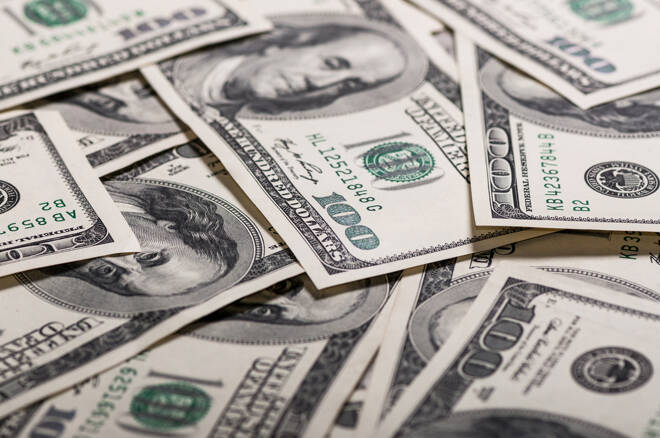Advertisement
Advertisement
EUR/USD Daily Technical Analysis for March 21, 2018
By:
The EUR/USD whipsawed generating an outside day, and closing lower on the session as the dollar gained traction against most major currencies. A worse
The EUR/USD whipsawed generating an outside day, and closing lower on the session as the dollar gained traction against most major currencies. A worse than expected German ZEW investor confidence figure also helped erode the value of the EUR/USD.
Technicals
The EUR/USD generated an outside day down, which is a reversal pattern, where the highs is greater than the prior days high and the low and close are lower than the prior days low. Prices are hugging up just above support which is an upward sloping trend line that comes in near 1.2250. A close below this level would lead to a test of the February lows at 1.2154. Momentum has turned negative as the MACD (moving average convergence divergence) index generated a crossover sell signal. This occurs as the MACD line (the 12-day moving average minus the 26-day moving average) crosses below the MACD signal line (the 9-day moving average of the MACD line).
German ZEW investor confidence deteriorated in March
The expectations index corrected much more than anticipated and fell to 5.1 in March, from 17.8 in the previous month, and with the March reading the lowest since September 2016. The current conditions indicator came in higher than anticipated, but was also down form February and overall the data confirms that investors are increasingly worried about escalating tensions over trade as well as the prospect of less accommodative central bank policies going forward, with the confirmation of a Brexit transition deal yesterday too late for the survey, but also unlikely to dampen concerns about the risk of a global trade war. Still, with central bank officials increasingly convinced that underlying inflation has turned a corner and that the output gap is closing, the weaker numbers are unlikely to prevent the ECB from phasing out QE and starting to eye rate hikes next year.
UK February inflation undershot expectations
UK February inflation undershot expectations, with the headline CPI rate falling to 2.7% year over year from January’s 3.0% and core CPI ebbing to 2.4% year over year from 2.7% year over year previously. The respective median forecasts had been for 2.8% year over year and 2.5%. PPI input and output prices also came in below forecasts, at 3.4% year over year in the case of the former, down from 4.5% in the month prior, and 2.6% year over year, down from 2.8% previously. The biggest downward contributions came from falls in transport and food prices.
Brexit transition deal too late for some EU companies
Brexit transition deal too late for some EU companies, which have already moved business and hiked prices as a result of the 2016 Brexit vote. A report published by the Chartered Institute of Procurement and Supply said nearly one in seven companies with U.K. suppliers have moved some of their business out of Britain, while almost a third of U.K. businesses with suppliers from the EU have increased prices as a result of the Brexit vote. The Transition deal was welcomed yesterday but some companies have already been activating contingency plans and nearly a quarter of U.K. businesses are planning to reduce their workforce to offset Brexit related costs, according to report. Meanwhile more than 1 in 10 EU companies have moved some of their employees out of the U.K. and 22% of British businesses are having problems securing contracts with EU suppliers after the March 2019 leaving date.
The ECB Mersch says they can reduce net asset purchases
The ECB Mersch says they can reduce net asset purchases, “while maintaining a sufficiently loose monetary policy to further support inflation in its path” towards the ECB’s goal, as “all preconditions for a sustainable adjustment of inflation” are in place. Unlike Praet last week, Mersch suggested yesterday evening that “the unemployment gap – a measure of overcapacity in the labor market, now seems close”. Still, even the dovish leaning Praet last week suggested that market expectations for an end to net asset purchases pretty soon and rate hikes starting to come on the agenda in the first or second quarter next year, are in line with the ECB’s intended policy path, so the central bank clearly is on the way to phase out QE by the end of the year.
German PPI inflation fell back
German PPI inflation fell back to just 1.8% year over year from 2.1% year over year in January and with prices down -0.1% month over month. As in headline HICP readings, the PPI number was mainly impacted by base effects from lower food and energy price inflation. Energy price inflation fell back to 1.8 % year over year from 2.2% year over year, the food price number dropped to 1.6% year over year from 2.0% year over year.
About the Author
David Beckerauthor
David Becker focuses his attention on various consulting and portfolio management activities at Fortuity LLC, where he currently provides oversight for a multimillion-dollar portfolio consisting of commodities, debt, equities, real estate, and more.
Did you find this article useful?
Latest news and analysis
Advertisement
